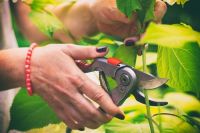
It’s time to trim back the dead heads of hydrangeas as their buds begin to swell into this year’s growth. Hydrangeas need little care apart from this annual haircut and spend the rest of their year growing into big, handsome shrubs covered later in summer with huge and showy blooms.
The best-loved hydrangeas, and the most commonly found in gardens, are the traditional mop heads (Hortensia) with their football-sized flower heads. But hydrangeas come in a surprisingly wide range of colours and flower forms.
Look out for the elegant lace caps with delicate, lacy flowers, and more compact varieties like ‘Annabelle’, covered in fat white ball-shaped flowerheads in late summer. And then there are the wilder hydrangeas such as handsome, rough-leaved giant H. aspera or smaller H. quercifolia, the oakleaf hydrangea, with architectural leaves turning deep scarlet and ochre in autumn. We have all these and more here at the garden centre in Hemlington and Middlesbrough and now is just the right time to plant these tremendously useful and versatile shrubs.
All hydrangeas hold their flower heads beautifully in winter, when their colourful bracts fade to shades of sepia brown that look gorgeous when rimed in frost. They fulfil a second function in keeping the developing leaf buds protected from the worst of the weather, but now that spring is warming things up it’s time to remove these spent flower heads ready for the new season.
Use a sharp pair of secateurs to cut back to just above the next healthy pair of buds down, working steadily across the whole bush until you have removed every flower head. While you’re there, check the plant over to see if there are any dead shoots and remove these right at the base, along with weak, weedy growth, to leave the strongest, healthiest stems to grow on and produce this year’s bright and beautiful blooms.

